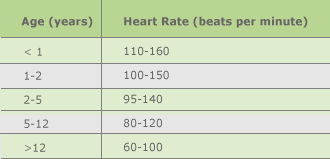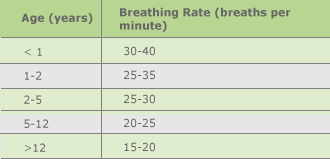What happens to a persons heart rate after inhaling dangerous chemicals?
Heart And Animate Rate
How is the breathing rate measured in a person?
Human respiration rate is measured when a person is at residuum and involves counting the number of breaths for ane minute past counting how many times the chest rises. An optical jiff rate sensor can be used for monitoring patients during a magnetic resonance imaging scan. Respiration rates may increment with fever, affliction, or other medical conditions. When checking respiration, it is important to also note whether a person has any difficulty breathing. Various other methods to measure respiratory rate are usually used, including impedance pneumography and capnography which are commonly implemented in patient monitoring.
In addition, novel techniques for automatically monitoring respiratory rate using wearable sensors are in development, such every bit estimation of the respiratory rate from the electrocardiogram, photoplethysmogram and acceleromatory signals.
What is a normal breathing rate?
The typical respiratory charge per unit for a salubrious adult at rest is 12–20 breaths per minute. Average resting respiratory rates by age are:
- birth to 6 weeks: thirty–60 breaths per minute
- 6 months: 25–40 breaths per minute
- 3 years: xx–30 breaths per minute
- 6 years: eighteen–25 breaths per minute
- x years: 17–23 breaths per minute
- Adults: 12-18-breaths per minute
- Elderly ≥ 65 years old: 12-28 breaths per minute.
- Elderly ≥ 80 years old: 10-30 breaths per minute.
What does respiratory minute volume mean?
Respiratory minute volume is the book of air which is inhaled (inhaled infinitesimal book) or exhaled (exhaled minute volume) from the lungs in one minute.
What does diagnostic value mean?
The value of respiratory rate every bit an indicator of potential respiratory dysfunction has been investigated but findings propose information technology is of limited value. Respiratory rate is widely used to monitor the physiology of acutely-ill hospital patients. It is measured regularly to facilitate identification of changes in physiology forth with other vital signs. This exercise has been widely adopted as part of early warning systems.
What is considered an abnormal Respiratory rate?
- Apnea
- Dyspnea
- Hyperpnea
- Tachypnea
- Hypopnea
- Bradypnea
- Ortopnea
- Patypnea
- Biot's respiration
- Cheyne-Stokes respiration
- Kussmaul animate
What is the science behind stress, heart rate and animate?
Throughout the twenty-four hour period, your heart rate increases or decreases depending on a number of factors – physical demand, chemical interactions (like coffee or nicotine), emotional episodes, and stressful situations. The mechanism past which your middle charge per unit increases in each of these situations is different, as are the implications of the heart rate increase on your overall health and wellbeing. Eye charge per unit control is a rest between the two circuits of the Autonomic Nervous Organization – the Parasympathetic Nervous System and the Sympathetic Nervous System.
- Sympathetic Nervous System (SNS) referred to as your "fight or flight" system.
- The Parasympathetic Nervous Arrangement (PSNS) can exist thought of as the "rest and assimilate" organization.
- Together, the PSNS and SNS piece of work in all areas of the body to assistance you act, react, and recover.
In the heart, although both systems are always running at the same time, the PSNS is the primary histrion in controlling middle rate at rest. Your eye charge per unit starts to increment as the SNS gains more than foothold. It is important to notation that although SNS activation is normal, certain lifestyle choices we make tin can cause its activation to be unnatural and prolonged, which can have lasting consequences on our health. The body responds to stress, worry and anxiety in the aforementioned ways that it responds to fright and excitement – past activating the "fight or flight" organization.
At a chemical level, your body releases a serial of hormones that brand you hyper-warning, focused, and energized, and this chemical pour causes increased heart rate, respiratory rate, and perspiration. Consider the archetypal story of the man beingness chased past the conduct. This is the essence of the evolved SNS, or "fight-or-flight" organisation.
To your body, all these instances are examples of stress, and your body has evolved to prepare you to handle these stressful periods for your survival and to render you lot to rubber. The issue today is that many of united states of america are constantly stressed, worried, or anxious, and every bit a result, we are overworking our sympathetic nervous arrangement, and non assuasive this "return to safe". I reason the SNS works so beautifully and can come to our rescue when we call is that it usually works in harmony with your "rest and digest" system. Y'all need both, and studies today take shown that when you are nether constant stress, your PSNS doesn't resume command when the battle is done – because the battle is constant – and thus the influence of the PSNS decreases.
Diminished PSNS activity at the mercy of increased SNS action results in chronic health issues such as anxiety, low, digestive bug, slumber problems, weight proceeds, retentiveness impairment, and allowed system depression. In terms of the heart, the dire story of stress continues, every bit the upshot of increased heart rate due to stress tin lead to high claret pressure, irregular eye rhythms, higher cholesterol, and coronary artery disease.
How tin can we command this?
Because increased middle charge per unit is an easy indicator of stress, we can combat our stress at a chemic level by recognizing when our heart rate is elevated, and so working to lower it. Fortunately, y'all hold the ability to continuously monitor your center rate on your wrist (your Basis lookout), and you tin can therefore be an active actor in reducing your stress.
How exercise we lower our center rate?
I issue of an increased heart rate is increased respiration, or animate rate. When people are stressed, they tend to have faster, more shallow breaths, in accordance to increased eye rate. This actually differs from faster animate due to increased heart rate from practise, and it is this difference that makes breathe control a powerful manner to lower your heart rate and stress simultaneously. When you have faster, shallower breaths, are you getting rid of CO2 in the blood faster than normal.
This may seem like a good thing, simply in fact, yous need CO2 just as much as you lot need oxygen in your blood, and low levels of CO2 in your claret causes the pH of your blood to modify, which can affect the function of your enzymes, organs, and muscles. Depression CO2 levels cause psychological furnishings, such as increased feelings of anxiety and fear, and in one case these feelings arise, your SNS activates, causing the "fight or flying" cycle to repeat. CO2 is of import, and controlling your breath as a manner to restore and maintain your CO2 levels in your claret is an important way to contrary the stress cycle, and come back downward to homeostasis.
Use your Basis sentry to your advantage throughout the day. When y'all notice your heart rate is increased, take a moment to focus on your breath. Then, try the following exercises to subtract your breathing charge per unit.
- Deep Controlled Breathing; This technique involves deep and slow 10-2d inhalation through the nose, followed by a slow and complete exhalation for x seconds.
- Diaphragmatic Breathing; The diaphragm is a large, sparse dome-shaped muscle that fans out at the base of our lungs. It is our about efficient breathing muscle, but can be compromised in people with chronic stress. In fact, chronically stressed people tend to use their accessory muscles rather than their diaphragm to breathe. This hinders their power to take deep breaths, which weakens the diaphragm and leads to rapid breaths. By getting more oxygen into your lungs then into your bloodstream, your muscles volition accept more fuel and your heart will be able to beat slower and with less effort. In this way, you will interrupt the "fight or flight" response and trigger the body's normal relaxation, or "residual and assimilate," response. When this occurs, the brain will send signals to the various hormone-producing organs, causing smaller amounts of stress hormones to exist released. This then enables the liver and kidneys regain command of the stress hormones in the blood stream, and the "fight or flight" response volition subtract and ultimately cease.
- Carotid Massage; In that location are times when you may accomplish a land of dire stress and anxiety – such equally a panic attack. By the time you lot realize the attack, information technology seems that y'all are spiralling downwards without rescue. This would be the fourth dimension to employ the Carotid Massage, which in essence, is a physical fashion for you to activate the PSNS immediately, and will cause your center rate, breathing charge per unit, and blood pressure level to decrease. The carotid artery runs from your aorta and subclavian arteries, up either side of your neck, and to your brain. Y'all know this artery, because you have your pulse from this artery. In fact, right at the area where you feel for your pulse, there is something called the "carotid baroreceptor". These baroreceptors have nerve endings that act as sensors so that the encephalon can notice changes in blood pressure level and reply appropriately. The way that the encephalon responds is by either activating the SNS (if blood pressure is detected as low) or the PSNS (if the blood pressure is detected as loftier), with the overall goal being to restore normal claret force per unit area. You can use the carotid massage equally a style to "flim-flam" your brain into thinking your claret pressure is loftier, which will cause it to activate the "rest and digest" response, and lower your heart rate. In order to achieve the Carotid Massage, take two fingers at your pulse, and gently massage in a circular move. You should outset to feel your body naturally slow down and relax.
What is the normal center, breathing and blood pressure level rates for children?
When the center or breathing (respiratory) charge per unit is slower or faster than normal, it is often a sign that all is not well. The heart rate (pulse) is elevated when children are unwell. Information technology might only be considering they have a fever but it may be something more than serious. If the heart charge per unit is slower than normal, particularly in babies, that likewise can exist a sign that non all is well. In babies the easiest place to feel the pulse is on the upper arm above the elbow articulation - experience under the biceps muscle. In older children, you can feel the pulse at the wrist.

A high respiratory (breathing) rate is ordinarily a sign of breathing difficulty just in children is also seen with heart conditions (like heart failure). Unremarkably when the rate is high due to animate difficulties, yous volition also run into signs of increased effort or work of animate.

scruggsmandell1956.blogspot.com
Source: https://www.sleeprenewal.co.za/heart-and-breathing-rate
0 Response to "What happens to a persons heart rate after inhaling dangerous chemicals?"
Post a Comment